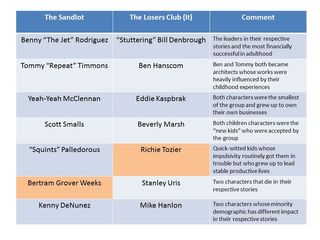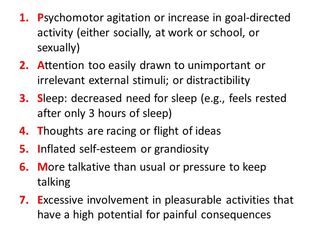
Bipolar Disorder
Analytic Perspectives on "It" and "The Sandlot"
Viewing Stephen King's "It" and "The Sandlot" through a psychiatrist's lens.
Posted September 5, 2019
The Participatory Cinema at the Rutgers Center of Alcohol Studies (CAS) is a monthly full-day seminar centered around a feature-length film that we flip as a fictional case study of mental illness (hence, CASe-based fiction). The purpose of the seminar is not to render diagnoses per se as it would run the risk of stigmatizing individuals with mental illness (films too often provide inaccurate portrayals of mental disorders). Instead, the selected film serves to stimulate discussion about the seminar’s topic (e.g. Bipolar and Related Disorders). This blog is a synopsis of our Participatory Cinema discussion on The Sandlot (1993).
Synopsis
The Sandlot is a “coming of age” adventure about a group of boys in the summer of 1962 and the role baseball plays in the development of their friendships. In the film, baseball provides a backdrop to their friendship and innocence. As of this posting, the film holds an 89% audience score on Rotten Tomatoes and a score of 7.8 out of 10 on IMDb.
During the closing credits, a voice-over by David Mickey Evans provides the audience with the outcomes of each character’s early childhood experiences. As such, the film bears a strange parallel to another film about childhood friendship and innocence that stretches across three decades (27 years to be exact): Stephen King’s It.
In King’s novel, Eddie Kaspbrak meets a zombified Belch Huggins during his ‘walking tour’ of Derry in 1985. Prior to the horrifying encounter, Eddie was re-experiencing 1958 and the memories of Belch and others playing baseball on the lot next to the Truck Depot. King’s nostalgic detail (1) is indistinguishable from the voice-over in The Sandlot. This post will merge the two films for purposes of discussing the Bipolar and Related Disorders.

How it Relates to Psychiatry
The parallels between the characters of The Sandlot and It are uncanny (Table 1). Despite these associations, I will highlight 2 characters – Richie Tozier and Bertram Grover Weeks – who I believe prompt a discussion of Bipolar Affective Disorder (BAD).
The Bipolar and Related Disorders chapter in the DSM-5 covers a group of disorders that have mania or hypomania as their core feature. In The Sandlot, there is no evidence that Bertram suffers from BAD. Observing and discussing the character in the context of BAD serves to reach three objectives. First, it is speculated that Bertram suffers from a substance use disorder as an adult; “Bertram got really into the ’60s … no one ever saw him again” (2). The second point reinforces the high rates of comorbid substance use disorder that have been observed in bipolar patients; for example, estimates of comorbid lifetime alcohol abuse have been reported to be as high as 69% (3).
In It (novel), an adult Rich Tozier “realized now that a lot of the problem had been his own mind, which was usually moving at a speed 10 or 20 times that of his classmates. They had thought him strange, weird, or even suicidal...but maybe it had been a simple case of mental overdrive” (4). Furthermore, the National Mental Health Association reports that up to 70% of suicide victims have suffered from a form of depression including bipolar depression (5). Despite Stephen King’s description consistent with the racing thoughts that define mania (Tozier is quite impulsive as well), this case formulation must also include the caveat of Disruptive Mood Dysregulation Disorder (DMDD). To address concerns about potential overdiagnosis of BAD in children like Richie Tozier, the new diagnosis of DMDD was included in the DSM-5 (2013) for children who exhibit persistent irritability and frequent episodes of extreme behavioral dyscontrol (beep beep, Richie!!).

As the title implies, The Sandlot is a film about a group of friends who are bonded through the pastime of baseball. Stephen King’s It tells of an inter-dimensional predator that awakens every 27 years (in Evans’ closing voice-over, he says Hercules lived to be 199 years old which in dog years is about 27 years!). While It’s “losers club” is connected by their being outcasts in the town of Derry, baseball also figures prominently as King nostalgically describes the group playing baseball with Belch Huggins in the lot next to Tracker’s Truck Depot. These films about our nation’s pastime allow for the review of mania and therefore BAD. As such, the signs and symptoms of mania may be remembered by the acronym PASTIME (Table 2). As part of our ‘extra innings bonus coverage,’ yet another tale about interpersonal relationships and baseball, Field of Dreams (1989), also depicts Bipolar Affective Disorder (but that’s a different blog!).
References
It, Stephen King, Scribner, Simon and Schuster, Inc., 1986, p. 561-564.
Evans DM, The Sandlot, 1993, IMDb, https://www.imdb.com/title/tt0108037/
Cassidy F, MD. Substance abuse in bipolar disorder, Bipolar Disorder, 2008.
It, Stephen King, Scribner, Simon and Schuster, Inc., 1986, p. 584.
Bhandari S, MD WebMD, 2018, July 12 https://www.webmd.com/bipolar-disorder/guide/bipolar-disorder-suicide

